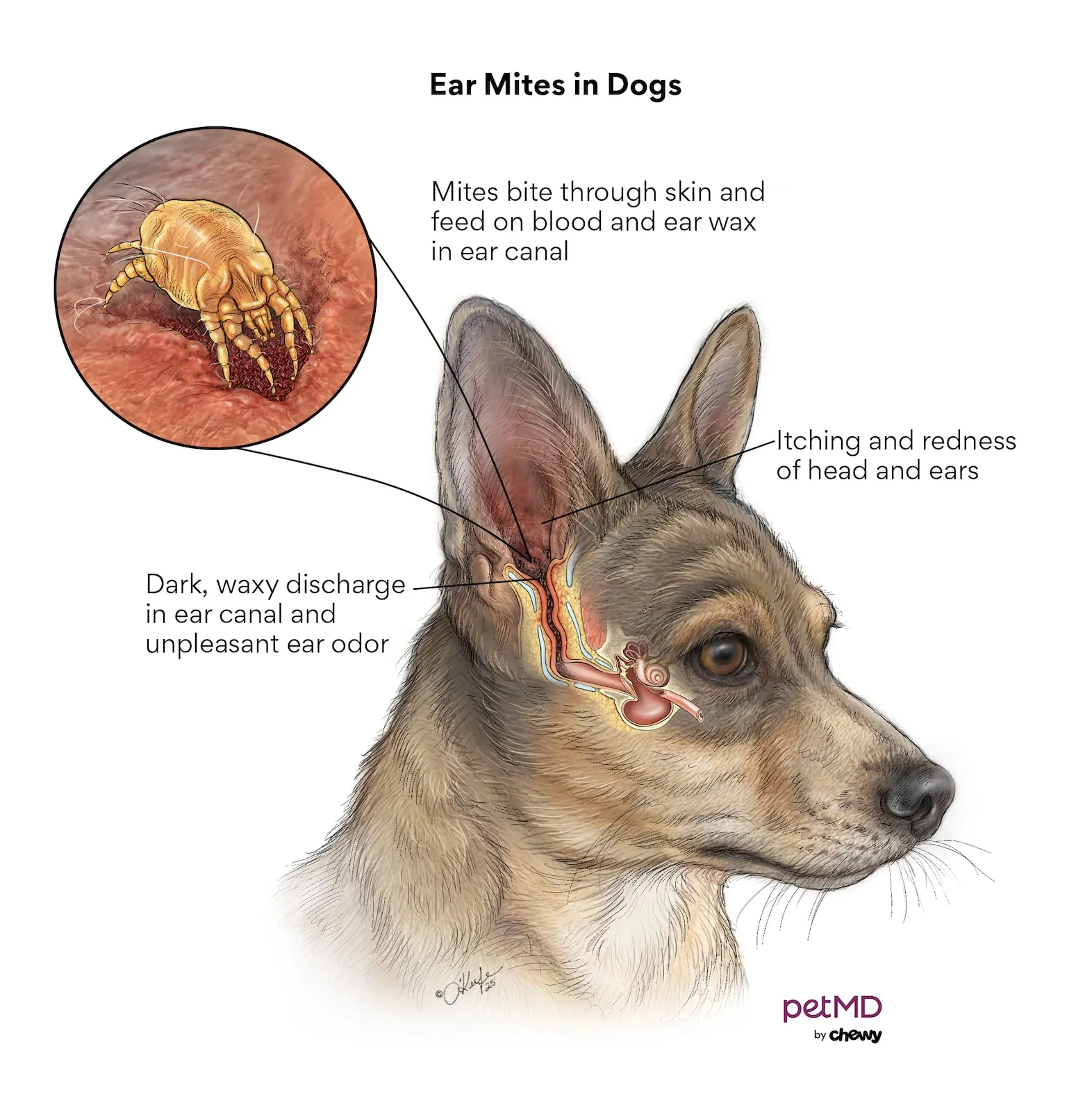If you notice your dog constantly shaking its head or scratching its ears, ear mites might be the cause. While ear mites are more common in cats, dogs, especially puppies and those who spend a lot of time outdoors, can also be affected. These tiny parasites reside in a dog’s ear canals, causing intense itching, pain, and discharge. But what about humans? Can Humans Get Ear Mites From A Dog? This article will explore that question, the symptoms of ear mites in dogs, and how to prevent and treat them.
 ear mites in dogs; a diagram with a dog that has mites within his ear.
ear mites in dogs; a diagram with a dog that has mites within his ear.
Symptoms of Ear Mites in Dogs
Identifying ear mites early can prevent secondary infections and discomfort for your furry friend. Common symptoms include:
- Excessive head shaking
- Intense itching and redness in the ears
- Unpleasant ear odor
- Thick, dark brown or black ear discharge
- Pain and sensitivity when touching the ears
- Head tilt
- Hair loss around the ears and eyes
- Decreased appetite
- Lethargy
If you observe any of these signs, consult your veterinarian for a proper diagnosis. It’s important to rule out other potential issues like allergies or infections. Early diagnosis and treatment are crucial for your dog’s comfort and well-being. Speaking of treatment, it’s also important to keep your dog protected from fleas and ticks. For more information, see flea medication for puppies under 12 weeks.
What Causes Ear Mites in Dogs?
Ear mites are highly contagious and primarily spread through close contact with infected animals. This includes dogs and cats. If one pet in a household has ear mites, it’s likely the others will too. Dogs can also pick up ear mites from contaminated environments, such as bedding or toys.
Dogs of all ages can contract ear mites. However, those not on regular flea, tick, and heartworm preventatives face an increased risk because they lack consistent parasite protection.
Diagnosing Ear Mites in Dogs
A veterinarian will conduct a thorough examination of your dog, paying close attention to the ears. They’ll use an otoscope to look for discharge or inflammation in the ear canals. They will also inquire about your dog’s preventative medications, the onset of symptoms, and whether other pets reside in the household.
If ear mites are suspected, a diagnostic test called an ear cytology is performed. This involves collecting a sample of debris from the ear canal with a cotton swab. The sample is then examined under a microscope to identify ear mites or their eggs. A second sample might be stained and examined to check for yeast or bacteria, which can cause secondary ear infections.
Can Humans Contract Ear Mites From Dogs?
While it’s extremely rare, humans can potentially get ear mites from dogs. Ear mites prefer animal hosts and don’t thrive on humans. However, if an ear mite accidentally jumps onto a person, it might cause temporary itchiness or a skin rash.
So, while the risk is low, maintaining good hygiene and treating your dog promptly can prevent any potential transfer.
Treating Ear Mites in Dogs
Treating ear mites involves thorough cleaning and medication.
Ear Cleaning: The ears are cleaned with an ear cleanser like Epi-Otic® Advanced. If a secondary bacterial infection is present, an antimicrobial cleanser like TrizULTRA™+ Keto Flush may be used. These cleansers remove debris, allowing medication to work effectively. They should be used daily until the mites and infection are gone.
Medication: Topical and oral flea, tick, and heartworm preventatives are highly effective. These products, like Bravecto® and Advantage Multi™, are often used off-label for ear mites under veterinary guidance. Topical medications are applied to the skin between the shoulder blades, while oral medications are given by mouth.
Additional Treatments: If a bacterial or yeast infection is present, a topical ointment like Animax® may be prescribed. In cases of severe itching or pain, the veterinarian might prescribe topical or oral steroids like prednisone.
Since ear mites are highly contagious, all pets in the household should be treated.
Recovery and Management
Usually, a single course of treatment suffices if ear cleanings and medications are administered as prescribed. Dogs typically feel better within a day or two of starting treatment, but it can take up to 30 days for the mites to be fully eliminated.
After treatment, follow-up veterinary visits are essential to ensure the ear mites are gone. If symptoms persist or ear cytology reveals remaining mites or infection, another round of treatment may be necessary.
Preventing Ear Mites in Dogs
Prevention is key to keeping your dog healthy and comfortable. Regularly using flea, tick, and heartworm preventatives year-round protects against ear mites. Weekly cleaning of your dog’s ears removes debris and reduces the risk of infections.
FAQs About Ear Mites
- Can ear mites infest my house?
- Ear mites can be found in bedding and toys that an infected animal has touched. However, they don’t survive long in the environment and can be eliminated with proper cleaning and disinfection.
- Do I need to take my dog to the vet for ear mites?
- Yes, veterinary treatment is necessary. Prescription medications are needed to eliminate the mites and reduce inflammation.
Conclusion
While the question, “Can humans get ear mites from a dog?” is valid, the chances are very low. Ear mites are primarily a concern for pets, especially dogs and cats. By understanding the symptoms, causes, and treatments for ear mites, you can protect your furry friend and maintain a healthy, happy home. Regular veterinary check-ups, preventative medications, and good hygiene practices will keep ear mites at bay and ensure your dog’s well-being.
